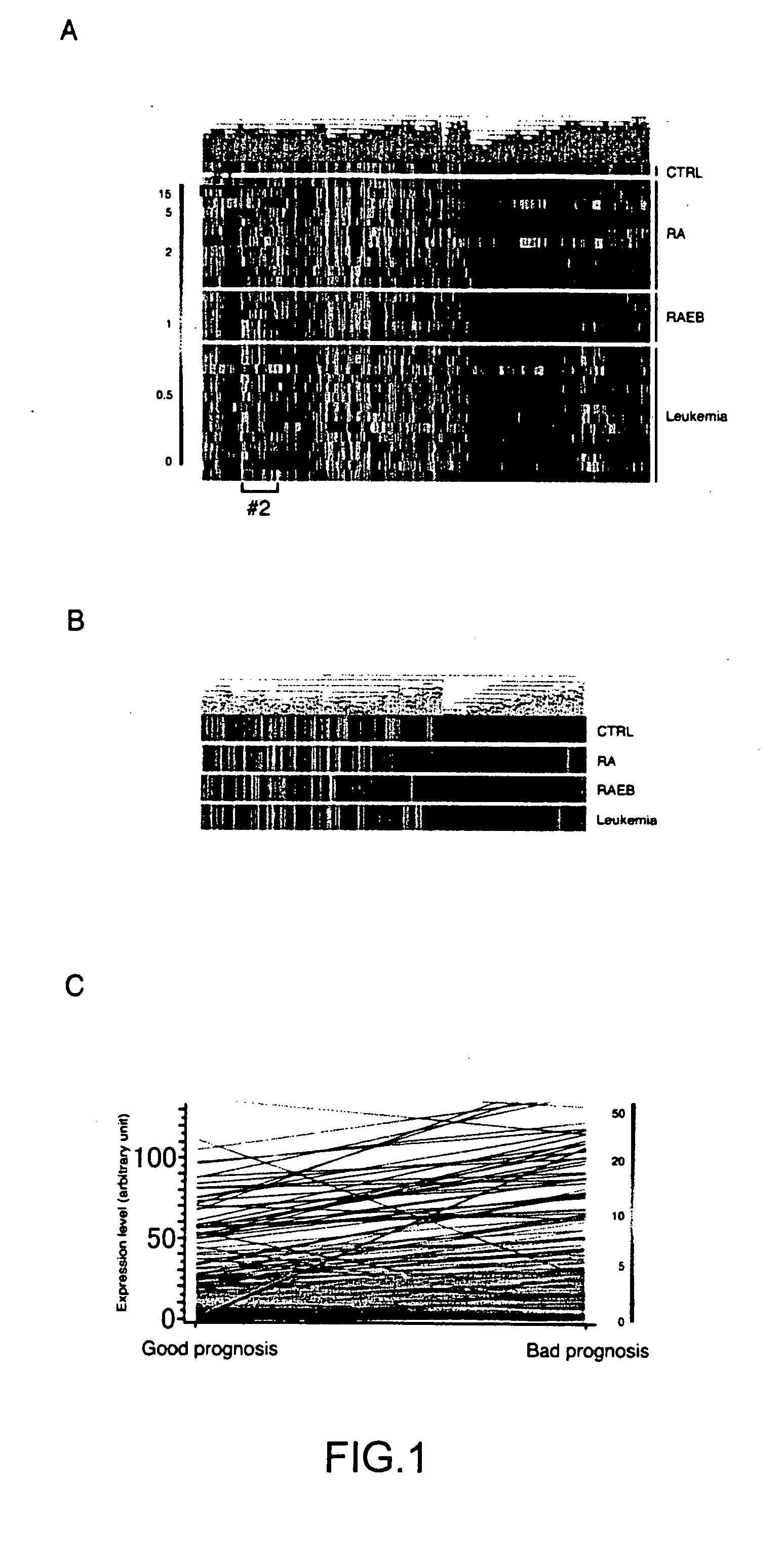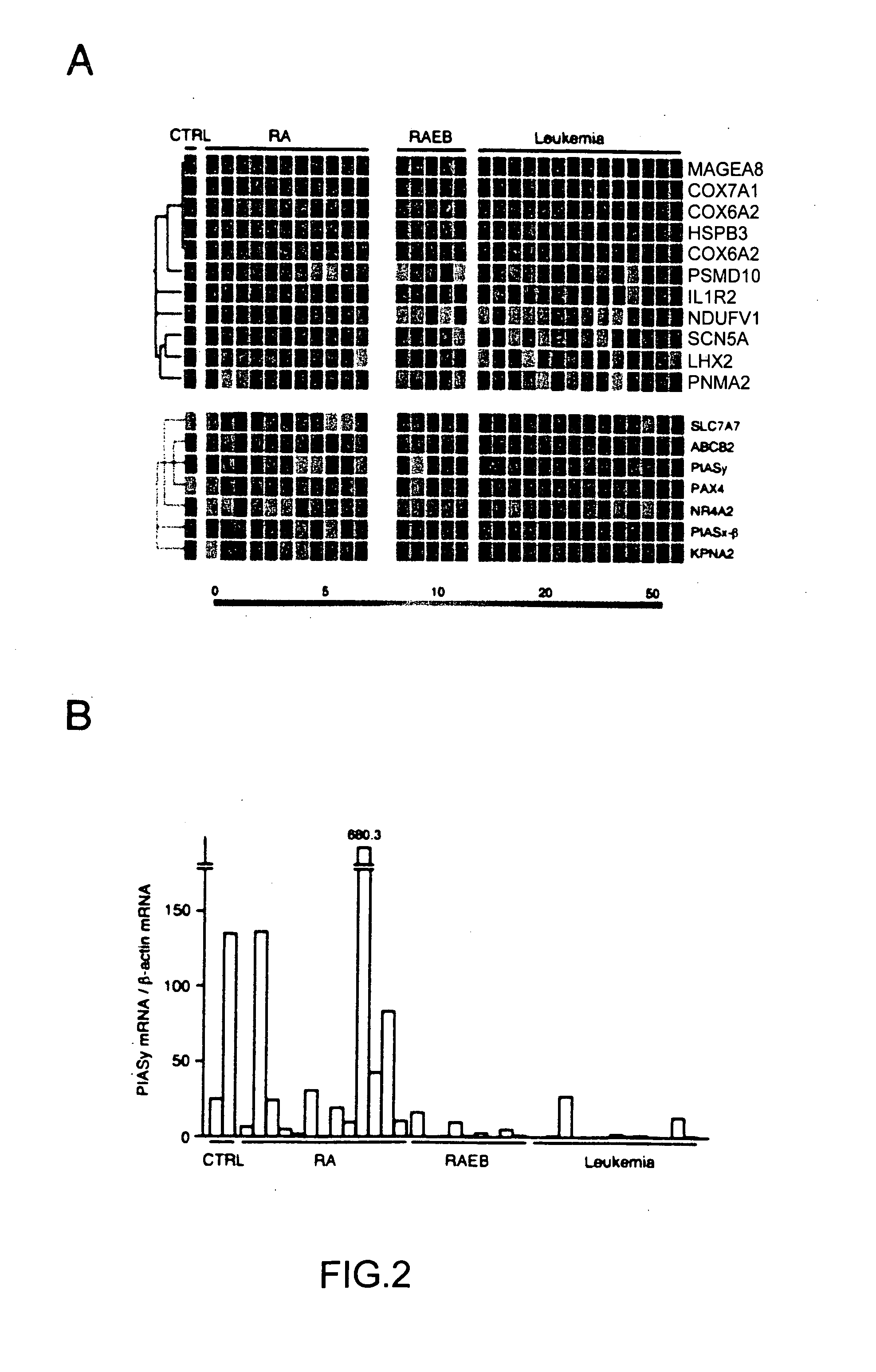Method for identifying myelodysplastic syndrome-specific genes
a technology for myelodysplastic syndrome and genes, applied in the field of method for identifying myelodysplastic syndrome (mds)specific genes, can solve the problem of subject judged to be at a risk of mds, and achieve the effect of efficient identification
- Summary
- Abstract
- Description
- Claims
- Application Information
AI Technical Summary
Benefits of technology
Problems solved by technology
Method used
Image
Examples
example 1
Transcriptome of MDS Samples
[0070] Expression profiles of 2304 human genes were obtained for the Blast Bank samples purified from 11 patients with reflactory anemia (RA), 5 patients with RA with excess of blasts (RAEB) and 14 patients with myelodysplastic syndrome (MDS)-associated leukemia. First, bone marrow (BM) aspirates were obtained from subjects with written informed consent, and used to prepare mononuclear cells (MNC). Cells were then labeled with anti-AC133 (hematopoietic stem cell (HSC)-specific cell surface marker) MicroBeads (Miltenyi Biotec, Auburn, Calif.), and loaded onto a miniMACS magnetic cell separation column (Miltenyi Biotec) according to the manufacturer's protocol. The resulting AC133+ cell fractions were divided into portions and stored at −80° C. as the Blast Bank samples. AC133+ cells were also purified from BM MNC of two healthy volunteers and mixed for use as a “healthy control” sample. The purity of each sample was confirmed by Wright-Giemsa staining. Wh...
example 2
Genes Induced Along with Stage Progression
[0075] One of the main goals in this study was to clarify the molecular events that drive the stage progression from the indolent RA to the therapy-refractory RAEB / MDS-associate leukemia. The inventor thus focused to elucidate the change of transcriptomes between the good prognosis stages (healthy control and RA) and the bad prognosis stages (RAEB and MDS-associated leukemias). The mean expression intensity for every gene was calculated within the good or bad prognosis group, and used to draw FIG. 1C to demonstrate the change of expression level between the two groups for every gene.
[0076] The inventor first tried to isolate genes, expression of which was induced in the AC133+ cells of the bad prognosis group compared to those of the good prognosis one. Toward this goal, with the help of GeneSpring software (Silicon Genetics), the inventor searched for any genes whose expression profiles were statistically similar, with a minimum correlati...
example 3
Genes Suppressed Upon Stage Progression
[0079] Given the essential roles of functional deficiency for various tumor-suppressors in the malignant transformation process, decrease of expression in certain genes may directly contribute to the stage progression in MDS as well. The inventor thus searched for any genes whose expression profiles were statistically similar to a hypothesized “good prognosis-specific gene” that has a mean expression level of 100.0 U in the good prognosis stage but of 0.0 U in the bad prognosis one. 182 such genes were identified, and further, genes whose expression values exceeded 70.0 U in at least one sample within the good prognosis group, and with those kept below 30.0 U in the bad prognosis group were selected, to finally identify 7 genes (blue-colored gene tree in FIG. 2A).
[0080] Among these control / RA-specific genes, of great interest would be those for PIAS family of signaling proteins, PIASy and PIASx-β (Shuai, K. (2000) Oncogene 19, 2638-2644). The...
PUM
 Login to View More
Login to View More Abstract
Description
Claims
Application Information
 Login to View More
Login to View More - R&D
- Intellectual Property
- Life Sciences
- Materials
- Tech Scout
- Unparalleled Data Quality
- Higher Quality Content
- 60% Fewer Hallucinations
Browse by: Latest US Patents, China's latest patents, Technical Efficacy Thesaurus, Application Domain, Technology Topic, Popular Technical Reports.
© 2025 PatSnap. All rights reserved.Legal|Privacy policy|Modern Slavery Act Transparency Statement|Sitemap|About US| Contact US: help@patsnap.com



